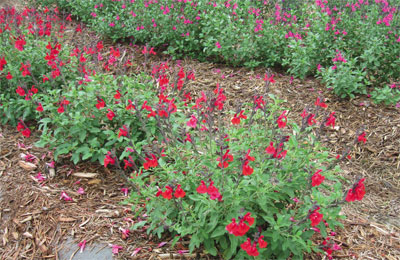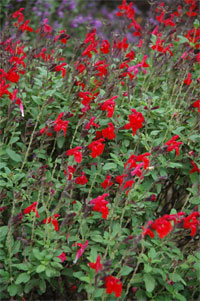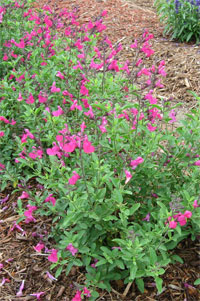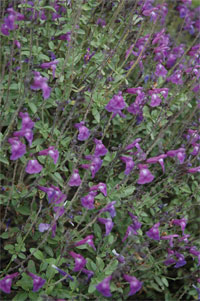Plant of the Month – September, 2009

Salvia Greggii ‘Mesa’ Red is shown in the foreground of this bed. Photos courtesy of Dallas Arboretum and Syngenta Flowers.
Salvia Greggii ‘Mesa’ series
AT A GLANCE
Latin name: Salvia Greggii ‘Mesa’ series
Common name: Autumn sage
Flowers: Scarlet, purple, rose or azure throughout summer
Foliage: Finely textured, deciduous
Mature height: 3 ft. tall by 3 ft. wide
Hardiness: Perennial to Zone 7
Soil: Well-drained
Exposure: Full sun
Water usage: Low
Sources: Mail order, internet, or local nurseries

‘Mesa’ Scarlet

‘Mesa’ Rose

‘Mesa’ Azure
Salvia greggii is one of the first plants that I ever knew by its the full and correct Latin name. In my initial days in horticulture, I was the “water-girl” at an all-organic nursery here in the DFW Metroplex – one that loved its native plants. We propagated several different varieties of S. greggii. It was the middle of August and I had been watering for what seemed like days on end (a reality in August in North Central Texas), when I dragged my hose across the gravel path to water still more plants. I looked up to see a mass of butterflies flocking with great excitement all around the salvia. Then I saw hummingbirds, a sight that continued until temperatures started to drop. It was then that I decided to enter the “field of my dreams.” I discovered my first love of a plant that day — Salvia greggii!
Over the years — like most anything in our society — things advanced and “better” variations of this plant were hybridized and made available to garden lovers. Many companies that produce plant material took interest in this drought-tolerant butterfly and hummingbird attractor. The new ‘Mesa’ series offers all colors that you would want to display in a landscape. ‘Scarlet’ is a nice bright red, ‘Azure’ a light purple with a white eye, ‘Purple’ a deep, pure purple, and ‘Rose’ a nice bright pink. All of these hybrids behave in the same manner. With an average height and width of 3 feet, they are a great size for any gardening situation. They do well in the ground or in containers as long as there is good drainage. I have noticed that in our Dallas Arboretum trial program this series does not tend to get as “woody” or as “leggy” as older varieties have in the past. ‘Mesa’ has a nice compact habit and is covered in blooms from spring until late fall.
There are very few pests or disease problems with the Salvia greggii ‘Mesa’ series. The few times I’ve seen it struggle have been when roots stayed too moist, resulting in the death of the plant. Like most salvias, this one loves full sun — the more the better. I have found over time that cutting plants back by a third after the heaviest bloom allows them to be in top performance all season long. This perennial hybrid has the tendency to stay evergreen in mild winters. Overwintering this plant should not be a problem in most of Texas.
This hybrid is becoming increasingly available to retail consumers. I suggest going to your favorite local nursery in the fall or winter and asking them to order it for the spring. You may have to be patient and wait, but it is definitely worth it. If you can’t find this particular series, then I recommend any Salvia greggii; they are all great plants.
In the end, there is nothing negative to say about ‘Mesa’. A wonderful producer of flowers, spring though fall, this salvia will prove a great attraction for sitting in your back yard, watching butterflies and hummingbirds feasting on sweet nectar. And this variety works well both in containers and in the ground! Salvia greggii is a tough and drought-tolerant plant that is easy to maintain 12 months out of the year. I truly believe ‘Mesa’ is the cure for any gardener’s “black thumb.” Try one and discover that gardening in Texas really can be easy with the right choice of plants.
About the author: Jenny Wegley is research and greenhouse manager at the Dallas Arboretum. Visit www.dallasplanttrials.org for more information on the Arboretum’s plant trials.
